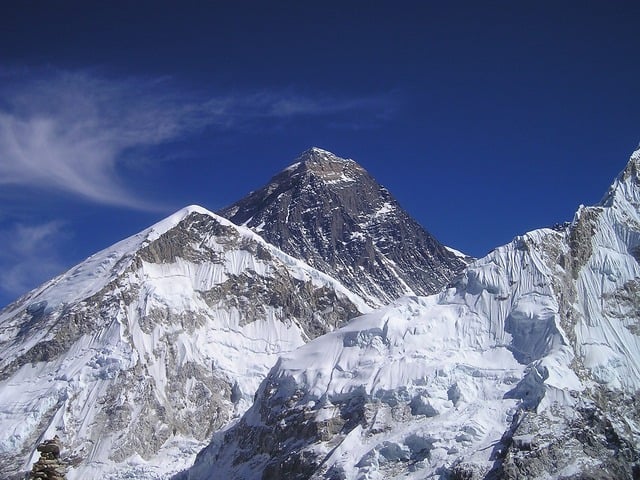Plantlife, including grasses, shrubs, and mosses, are growing and expanding at high altitudes around the Mt. Everest region across the Himalayas. The area continues to witness the impacts of global warming, where vegetation was not previously known to grow, new research has shown.
The NASA Landsat satellite data from 1993 to 2018 is used by a team of remote sensing scientists from the University of Exeter in the United Kingdom to measure the extent of plant cover between the tree-line and the snowline.
The results published in the journal Global Change Biology.
The study focused on the area between the tree-line and the snowline. It is known as the subnival region. The tree-line is the edge of the habitat where trees are capable of growing, while the snow line is the boundary between snow-covered land and snow-free land.
Subnival plants are mainly small grasses and shrubs.
“There are now more areas that are covered in plants than there were in 1993,” said Dr Karen Anderson, from Exeter University, the lead author of the report. “The strongest trend in increased vegetation cover was between 5,000 metres and 5,500 metres altitude.”
“At higher elevations, the expansion was strong on flatter areas while at lower levels that has been observed on steeper slopes.”
The researchers divided the heights between 4,150m and 6,000m (13,615-19,685 feet) above sea level into four “brackets” using Landsat satellite images of NASA.
The different locations in the Hindu Kush Himalayas were covered, ranging from Myanmar in the east to Afghanistan in the west.
The study found a “small but significant” increase in vegetation in all height brackets of the Everest region.
In the Himalayas, other researchers and scientists who are working on glaciers and water systems have confirmed the expansion of vegetation.
“It (the research) matches the expectations of what would happen in a warmer and wetter climate,” said Prof Walter Immerzeel, with the faculty of geosciences at Utrecht University in the Netherlands, who was not involved in the study.
“This is a very sensitive altitudinal belt where the snowline is. A withdrawal of the snowline to higher altitudes in this zone provides opportunity for vegetation to grow.”
However, the research did not examine the causes of the change.
As per the other research, Himalayan ecosystems are highly vulnerable to climate-induced shifts of vegetation.
“We have found the tree-line expanding in the subalpine regions of Nepal and China as the temperature rises,” said Achyut Tiwari, assistant professor with the department of botany at Nepal’s Tribhuvan University.
“If that is happening with trees at lower elevations, clearly the plants at higher altitudes will also be reacting to the rise in temperature.”
Some scientists who visit the Himalayas regularly have confirmed this picture of expanding vegetation.
Plants are indeed colonising the areas that once were glaciated in some of these Himalayas,
said Elizabeth Byers, a vegetation ecologist who has carried out field studies in the Nepalese Himalayas for nearly 40 years.
“At some locations where there were clean-ice glaciers many years ago, now there are debris-covered boulders, and on them you see mosses, lichens, and even flowers.”
Most scientific studies have focused on retreating glaciers and the expansion of glacial lakes amid rising temperatures. Therefore little is known about plants growing at these even-higher altitudes.
The researchers said it is required to understand how the plants interact with snow and soils in detailed field studies on vegetation in the high Himalayas.
“What does the change in vegetation mean for the hydrology (the properties of water) in the region is one of the key questions,” said Dr Anderson.
“Will that slow down the melting of glaciers and ice sheets or will it accelerate the process?”
From Afghanistan in the west to Myanmar in the east, the Hindu Kush Himalayan region extends across all or part of eight countries. More than 1.4 billion people are dependent on the water from this region.
“We know that plants and the water cycle are coupled,” Anderson explained. “Wherever you have plants growing, it changes the way the water cycle behaves in those areas.”
“This is particularly important in the Himalayas because glaciers are receding, and we know from lots of scientific work that this is already having an impact on water supplies in this region and it will continue to do so as climate change continues,” she added.
Climate change is already affecting Himalayan communities. It is already resulting in flooding and could ultimately result in drought. Since the beginning of this century, Himalayan glaciers have been losing almost half a meter ice each year, a 2019 study from Columbia University found.
An assessment from the International Centre for Integrated Mountain Development, an intergovernmental body covering the Hindu Kush Himalaya region, found last year that at least one-third of the vast ice fields of this region, which is home to Mt. Everest and K2, could melt by the end of 2100.






